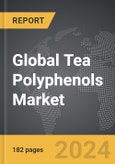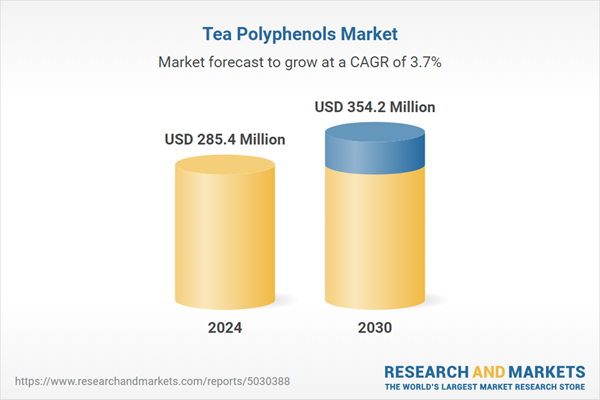The global market for Tea Polyphenols was valued at USD 285.4 Million in 2024 and is projected to reach USD 354.2 Million by 2030, growing at a CAGR of 3.7% from 2024 to 2030. This comprehensive report provides an in-depth analysis of market trends, drivers, and forecasts, helping you make informed business decisions.
Global Tea Polyphenols Market - Key Trends and Drivers Summarized
What Are Tea Polyphenols and Why Are They Important?
Tea polyphenols are natural antioxidants found in tea leaves, known for their wide-ranging health benefits. These bioactive compounds, including catechins, flavonoids, and tannins, have been studied extensively for their potential to reduce the risk of chronic diseases such as cardiovascular disease, cancer, and neurodegenerative conditions. With the growing interest in functional foods and beverages, tea polyphenols have gained attention for their antioxidant, anti-inflammatory, and anti-carcinogenic properties. These compounds are primarily sourced from green, black, and oolong teas, with green tea being the richest source. As consumers become more health-conscious, the demand for products enriched with tea polyphenols is on the rise, particularly in the nutraceutical, food, and beverage sectors.How Are Tea Polyphenols Being Used Across Industries?
Tea polyphenols are widely used in the food, beverage, and nutraceutical industries. In the beverage industry, they are a key ingredient in green tea extracts, functional drinks, and ready-to-drink (RTD) teas, marketed for their antioxidant properties. The food industry incorporates tea polyphenols in various health-oriented products, such as dietary supplements, baked goods, and snacks, where they offer functional benefits alongside flavor enhancement. The nutraceutical industry is also capitalizing on tea polyphenols' health benefits by developing supplements that target specific health conditions, such as heart disease or weight management. In addition, the cosmetic industry is increasingly using tea polyphenols in skincare products due to their anti-aging and anti-inflammatory properties.What Are the Key Trends Driving the Tea Polyphenol Market?
The tea polyphenol market is being shaped by several trends, including the growing consumer demand for natural antioxidants, the rise of functional beverages, and the increasing focus on clean-label ingredients. As consumers seek natural solutions to boost their overall health, products enriched with tea polyphenols are gaining popularity, particularly in markets like Asia-Pacific, North America, and Europe. The functional beverage market is a major growth area, with tea polyphenols being used in everything from RTD teas to functional waters and energy drinks. Additionally, the clean-label trend is driving demand for polyphenols derived from natural sources, as consumers look for products free from artificial additives. Innovation in extraction technologies is also playing a crucial role, allowing manufacturers to extract higher concentrations of polyphenols while maintaining product purity.The Growth in the Tea Polyphenol Market Is Driven by Several Factors
The growth in the tea polyphenol market is driven by several factors, including the rising consumer awareness of the health benefits of natural antioxidants, increasing demand for functional foods and beverages, and the clean-label movement. As consumers prioritize health and wellness, the demand for products containing natural bioactive compounds like tea polyphenols is surging. The expansion of the functional beverage market, particularly in the form of RTD teas and antioxidant-enriched drinks, is a key growth driver. Furthermore, advancements in extraction technologies are enabling the development of high-purity polyphenol products, which appeal to health-conscious consumers. The nutraceutical industry's increasing use of tea polyphenols in dietary supplements and weight management products is also contributing to market growth. As the demand for natural antioxidants continues to rise, the tea polyphenol market is poised for significant expansion.Report Scope
The report analyzes the Tea Polyphenols market, presented in terms of market value (USD Thousand). The analysis covers the key segments and geographic regions outlined below.Segments
Type (Green Tea Polyphenols, Oolong Tea Polyphenols, Black Tea Polyphenols); Application (Functional Beverages, Functional Food, Dietary Supplements, Cosmetics, Other Applications).Geographic Regions/Countries
World; United States; Canada; Japan; China; Europe (France; Germany; Italy; United Kingdom; Spain; Russia; and Rest of Europe); Asia-Pacific (Australia; India; South Korea; and Rest of Asia-Pacific); Latin America (Argentina; Brazil; Mexico; and Rest of Latin America); Middle East (Iran; Israel; Saudi Arabia; United Arab Emirates; and Rest of Middle East); and Africa.Key Insights:
- Market Growth: Understand the significant growth trajectory of the Green Tea Polyphenols segment, which is expected to reach $260.3 Million by 2030 with a CAGR of a 3.7%. The Oolong Tea Polyphenols segment is also set to grow at 3% CAGR over the analysis period.
- Regional Analysis: Gain insights into the U.S. market, valued at $75.2 Million in 2024, and China, forecasted to grow at an impressive 6.6% CAGR to reach $77.7 Million by 2030. Discover growth trends in other key regions, including Japan, Canada, Germany, and the Asia-Pacific.
Report Features:
- Comprehensive Market Data: Independent analysis of annual sales and market forecasts in USD from 2024 to 2030.
- In-Depth Regional Analysis: Detailed insights into key markets, including the U.S., China, Japan, Canada, Europe, Asia-Pacific, Latin America, Middle East, and Africa.
- Company Profiles: Coverage of major players such as Amax NutraSource, Inc., Barry Callebaut AG, Chr. Hansen Holding A/S, Frutarom Industries Ltd., FutureCeuticals and more.
- Complimentary Updates: Receive free report updates for one year to keep you informed of the latest market developments.
Why You Should Buy This Report:
- Detailed Market Analysis: Access a thorough analysis of the Global Tea Polyphenols Market, covering all major geographic regions and market segments.
- Competitive Insights: Get an overview of the competitive landscape, including the market presence of major players across different geographies.
- Future Trends and Drivers: Understand the key trends and drivers shaping the future of the Global Tea Polyphenols Market.
- Actionable Insights: Benefit from actionable insights that can help you identify new revenue opportunities and make strategic business decisions.
Key Questions Answered:
- How is the Global Tea Polyphenols Market expected to evolve by 2030?
- What are the main drivers and restraints affecting the market?
- Which market segments will grow the most over the forecast period?
- How will market shares for different regions and segments change by 2030?
- Who are the leading players in the market, and what are their prospects?
Some of the 13 major companies featured in this Tea Polyphenols market report include:
- Amax NutraSource, Inc.
- Barry Callebaut AG
- Chr. Hansen Holding A/S
- Frutarom Industries Ltd.
- FutureCeuticals
- Herza Schokolade GmbH & Co. KG
- Indena SpA
- Koninklijke DSM NV
- Martin Bauer GmbH & Co. KG
- Naturex SA
- Prinova Europe Ltd.
- S.A. Ajinomoto OmniChem N.V - NaturalSpecialities
- Sabinsa Corporation
- Seppic SA
- Tianjin Jianfeng Natural Product R&D Co., Ltd.
Table of Contents
I. METHODOLOGYII. EXECUTIVE SUMMARY2. FOCUS ON SELECT PLAYERSIII. MARKET ANALYSISCANADAITALYSPAINRUSSIAREST OF EUROPESOUTH KOREAREST OF ASIA-PACIFICARGENTINABRAZILMEXICOREST OF LATIN AMERICAIRANISRAELSAUDI ARABIAUNITED ARAB EMIRATESREST OF MIDDLE EASTIV. COMPETITION
1. MARKET OVERVIEW
3. MARKET TRENDS & DRIVERS
4. GLOBAL MARKET PERSPECTIVE
UNITED STATES
JAPAN
CHINA
EUROPE
FRANCE
GERMANY
UNITED KINGDOM
ASIA-PACIFIC
AUSTRALIA
INDIA
LATIN AMERICA
MIDDLE EAST
AFRICA
Companies Mentioned (Partial List)
A selection of companies mentioned in this report includes, but is not limited to:
- Amax NutraSource, Inc.
- Barry Callebaut AG
- Chr. Hansen Holding A/S
- Frutarom Industries Ltd.
- FutureCeuticals
- Herza Schokolade GmbH & Co. KG
- Indena SpA
- Koninklijke DSM NV
- Martin Bauer GmbH & Co. KG
- Naturex SA
- Prinova Europe Ltd.
- S.A. Ajinomoto OmniChem N.V - NaturalSpecialities
- Sabinsa Corporation
- Seppic SA
- Tianjin Jianfeng Natural Product R&D Co., Ltd.
Table Information
| Report Attribute | Details |
|---|---|
| No. of Pages | 182 |
| Published | April 2025 |
| Forecast Period | 2024 - 2030 |
| Estimated Market Value ( USD | $ 285.4 Million |
| Forecasted Market Value ( USD | $ 354.2 Million |
| Compound Annual Growth Rate | 3.7% |
| Regions Covered | Global |









